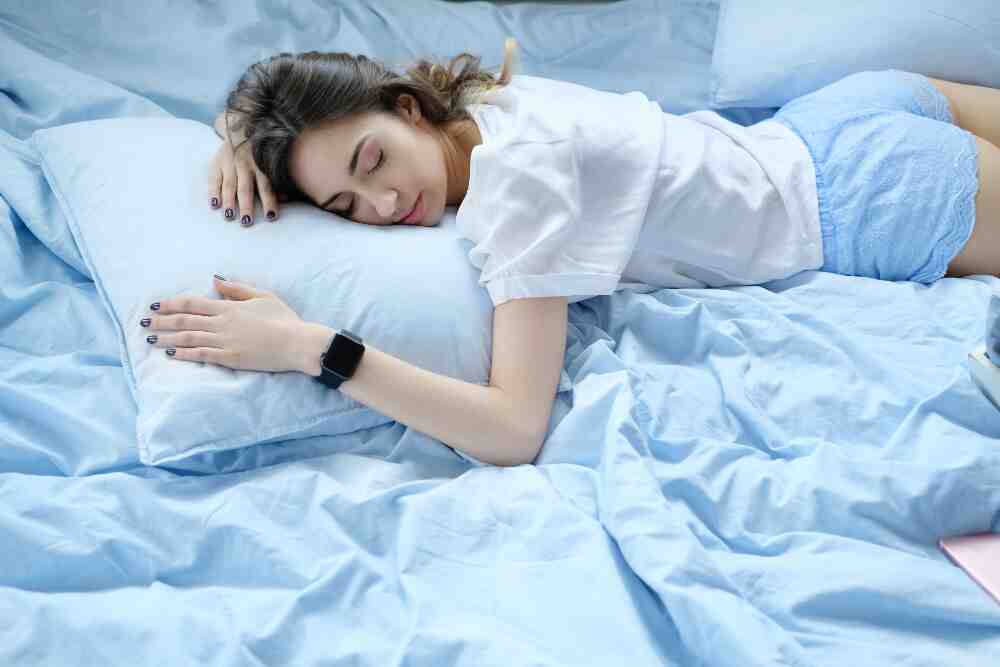Not sleeping well or not able to fall asleep? In todays modern busy world it is a common phenomena. Don’t despair, because yoga is here to save the day! The following eight yoga poses will geared towards helping you have a peaceful night’s sleep. If you add these poses to your bedtime routine, then both body and mind will be relaxed and they can prepare themselves for sleep.
Sleep from medical perspective
To put it simply, sleep is an everyday phenomenon where your awareness shifts, consciousness relaxes and muscles cool off. It’s a normal process that plays a major role in various roles of the body, such as helping you heal from illnesses or sorting out your memories or simply keeping you in good health. There are two main types of sleep, one with rapid eye movement (REM), and another without much eye movement (NREM). Running smoothly during sleep is a combination of chemicals, hormones and parts of the brain working together. Also, if the sleep gets messed up it can seriously affect your mood, how you feel about yourself and even how well your brain works.
Yoga Poses for Improved Sleep Quality
1. Child’s Pose (Balasana)
This is an ideal starting pose for your bedtime yoga routine. It also helps relieve tension in the back and shoulders, which can make one feel relaxed and calm.
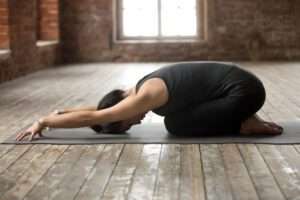
- To start, kneel on floor with toes together and sit back on heels.
- Carefully allow your torso to lower and rest your forehead on the mat or a pillow.
- Hold your arms out in front of you or at each side, and turn the palms up.
- , breathe slowly and deeply, letting go of any stress or tension in the body. Then surrender into the pose.
If you have tight hamstrings or lower back problems, use a folded blanket or bolster under your hips for support.
2. Ananda Balasana
Ananda Balasana, or Happy Baby Pose, promotes relaxation for better sleep, enhances hip flexibility, and relieves lower back tension
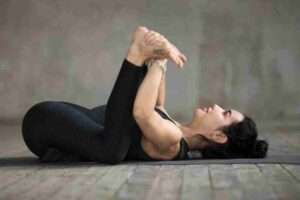
- Lie on your back
- Grab your feet.
- Gently rock side to side
For added benefits, practice deep, mindful breathing to enhance the calming effects.
3. Setu Bandhasana ( Bridge pose)
Setu Bandhasana, or Bridge Pose, aids in sleep by relieving stress, strengthening the legs, and calming the mind;
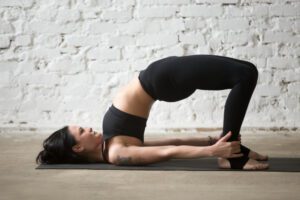
- Lie on your back.
- Lift your hips.
- Clasp your hands beneath you.
For an extra soothing touch, focus on slow, rhythmic breaths during the pose.
4. Legs-Up-the-Wall Pose (Viparita Karani)
This pose is good for better sleep as it helps to relaxing the nervous system, releasing tension and promoting blood circulation..
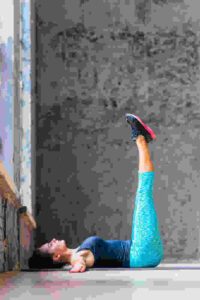
- Sit sideways, with your right hip against the wall..
- Swing your legs up against the wall, lowering your back gently onto the mat.
- Place your arms by your sides, hands up and rest the entire body..
- Use gravity to lengthen your hamstrings and melt all the tensile stress in your legs and lower back.
If you have tight hamstrings or lower back problems, place a folded blanket or bolster under your hips for comfort.
5. Standing Forward Bend (Uttanasana)
This pose helps to calm down the mind, relieves tension and stretches the hamstrings. It is especially helpful for people who sit all day long on the job.
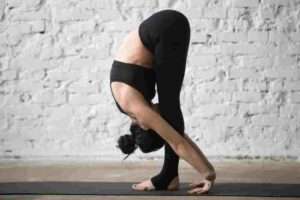
- Stand with your feet hip-width apart, hands on your hips.
- Inhale deeply, lengthening your spine.
- Exhale as you hinge forward at the hips, folding your torso over your legs.
- Allow your head and neck to relax, and if possible, let your hands reach for the ground or grab opposite elbows.
- Focus on releasing tension in your neck and shoulders as you breathe deeply into the pose.
If your hamstrings are tight, you can bend your knees slightly or put your palms on blocks at their ends for support.
6. Reclining Bound Angle Pose (Supta Baddha Konasana)
This is a simple hip opener. It relieves tension and increases relaxation. It also activates the parasympathetic nerves system, which is responsible for digestion and slumber.
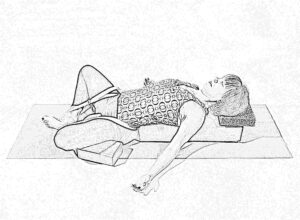
- Lie on your back with your feet together and your knees wide to the sides.
- Put your hands on your stomach or at your sides, palms facing up.
- Close your eyes and try to concentrate on your breathing, allowing your body to completely yield to the stance.
- Stay in this position for a few minutes. Feel the small opening in your hips and the sensation of comfort it provides to your entire body..
If you feel any discomfort in your knees, you can support them by placing pillows or blankets under each thigh
7. Supine Spinal Twist (Supta Matsyendrasana)
This twist helps to release tension in the spine, hips, and lower back, promoting relaxation and relieving any built-up stress or tightness in these areas.
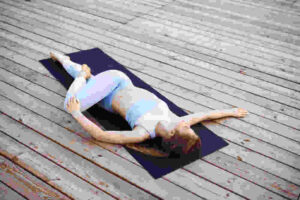
- Lie on your back with your knees bent and your feet flat on the mat.
- Extend your arms out to the sides in line with your shoulders.
- Slowly drop both knees to the right side of your body, keeping your shoulders grounded.
- Turn your head to the left and gaze in the opposite direction of your knees.
- Take slow, deep breaths and allow gravity to gently deepen the twist.
If your knees don’t comfortably touch the ground, you can place a bolster or folded blanket underneath them for support.
8.Corpse pose (Savasana)
Corpse Pose (Savasana) promotes restful sleep by inducing deep relaxation, reducing stress, and calming the nervous system

- Lie on your back.
- Close your eyes.
- Focus on steady, mindful breathing.
For enhanced tranquility, try incorporating gentle meditation or soothing music.
Extra Tips for Improved Sleep Quality.
Create a Relaxing Atmosphere: Before starting your bedtime yoga practice, create a calming ambiance in your bedroom. Dim the lights, light some candles, and play soothing music to help set the mood for relaxation.
Establish a Bedtime Routine: Consistency is key when it comes to improving sleep. Establish a regular bedtime routine that includes your chosen yoga poses. This will signal to your body and mind that it’s time to unwind and prepare for sleep.
Practice Mindfulness and Deep Breathing: While performing your yoga poses, focus on your breath and bring your attention to the present moment. Practice deep, slow breathing to activate your body’s relaxation response and quiet your busy mind.
Limit Screen Time Before Bed: The blue light emitted by electronic devices can interfere with your sleep-wake cycle. Try to limit your screen time at least an hour before bed to give your brain a chance to wind down.
Conclusion
Incorporating these eight yoga poses into your bedtime routine can be a game-changer when it comes to improving the quality of your sleep. Remember to personalize your practice by adding variations that work best for your body and listen to your intuition. With a consistent practice and a commitment to self-care, you’ll be well on your way to a peaceful and rejuvenating night’s sleep. So, roll out your mat, take a deep breath, and get ready to embark on a journey of rest and relaxation. Sleep tight! Also read 8 Excellent Yoga for seniors.
Faq.
Why incorporate yoga into a bedtime routine?
Bed time yoga helps to relax the body and mind. Thus making it easier to move into a restful sleep.
Which specific yoga poses are best for promoting better sleep?
Among the recommended poses are favorites like Child’s Pose, Legs Up the Wall, and Corpse Pose, each designed to release tension and calm the nervous system
How long should one hold each yoga pose for optimal sleep benefits?
Holding each pose for at least 5-10 minutes allows the body to fully relax and encourages a deeper sense of tranquility conducive to improved sleep.
Can beginners benefit from these sleep-inducing yoga poses?
Absolutely! The suggested yoga poses are beginner-friendly, offering a gentle introduction to the practice for those new to yoga.
Are there additional tips to enhance the effectiveness of these yoga poses for better sleep?
Incorporating deep mindful breathing, dimming lights, and creating a calming atmosphere maximizes positive impact on sleep quality.
